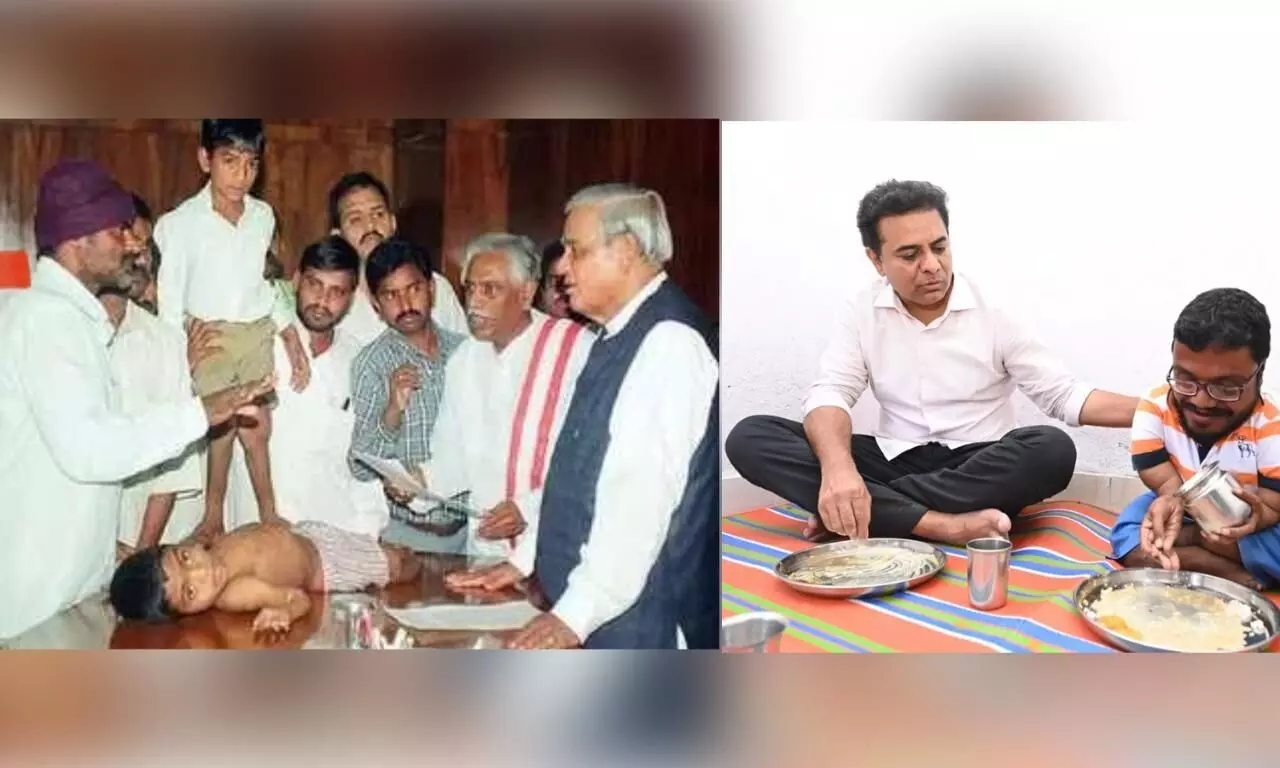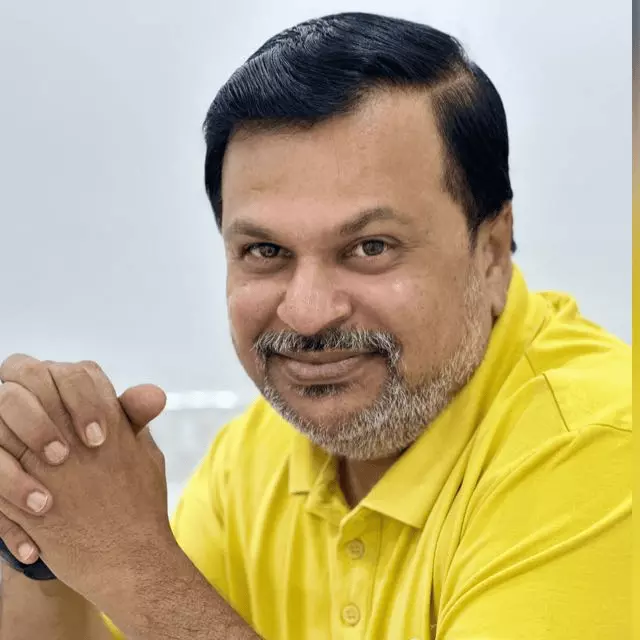Once lay crippled on PM's table, Swamy squats to lunch with KTR
Squatting comfortably on the floor covered by a dhurrie along side Swamy, KTR lunched with them

Amshala Swamy - KTR
A crippled Amshala Swamy was lay on the office table of the Prime Minister of India, Atal Bihari Vajpayee, in 1996, just with an intent of presenting the sad state of how the fluorosis was debilitating a whole population of a few districts in the then Andhra Pradesh. The angst of those in choosing to do so has a long history. They were exasperated owing to the apathy of the rulers for ages and finally 'tabled' the problem in front of the Prime Minister.
Duscharla Satyanarayana, a staffer in Andhra Bank and later in Union Bank of India, chose to give up the comforts of the cushy job he had been enjoying only with a view to espousing the cause of the fluoride-affected populace. The one who lent him the shoulder was Kanchukatla Subhash in the effort.
While Satyanarayana had launched 'Jala Sadhana Samithi' and Subhash led 'Fluorosis Vimukti Porata Samithi'.
Their war against the dreaded diseases afflicting people, just because they had no alternative but to consume the water polluted by fluoride, lasted long enough. They had met numerous leaders, influencers, social activists, Chief Ministers and Prime Ministers, only to be disappointed, yet rebooting themselves to demonstrate their perseverance in continuing their pursuit.
All that the duo had done was not for meeting their greedy selfish ends. Their sincerity in the social cause they took upon their shoulders turned out to be a long-winding, turbulent and protracted crusade which oftentimes fell on deaf ears.
After Telangana was carved out into a separate State, Chief Minister K Chandrashekar Rao indeed girded up his loins to eradicate fluoride problem from 967 villages in erstwhile Nalgonda district impacting over a lakh of people. In fact, the fluoride problem was one of the important postulates that was projected by the TRS among the causes for a separate statehood agitation.
The idea of providing protected potable drinking water through pipelines across Telangana came as a boon to the people in the fluoride-affected villages.
Several thousands of people had suffered from stunted growth, skewed legs, feet and fingers, withered and decayed teeth. Some of them fell prey to the chemical-induced ailment and succumbed too.
Now what about Satyanarayana and Subhash. Nothing, indeed, except for paying glorious tributes to the decades-long movement they spearheaded. Meeting of Amshala Swamy by Telangana IT Minister K T Rama Rao became an occasion to recall the contribution of Satyanarayana and Subhash. KTR's contrite gesture wiped out the decades of neglect by successive governments.
Amshala Swamy, as a baby, was carried in 1996 to then Prime Minister Vajpayee by Satyanarayana who had highlighted the intensity of the problem and severity of the gross neglect of the villages.
What did KTR do
News reports and a tweet to him about the sorry state of Amshala Swamy moved the Minister K T Rama Rao. Touched by Swamy's plight, KTR donated Rs 5 lakh from his personal funds and had Swamy set up a haircutting salon. For, Swamy acquired the skill of his family's profession. Later, KTR had a double bedroom house sanctioned to him. Swamy who thanked KTR profusely for infusing life and kindling hope in him in many a media interaction was pleasantly surprised on Thursday.
For what? An unexpected guest visited his native village Shivanna Gudem in Marriguda mandal of Nalgonda district. That was KTR along with his colleague minister G Jagadish Reddy and a few TRS leaders joining Swamy for lunch at his small two bedroom house. Squatting comfortably on the floor covered by a dhurrie along side Swamy, KTR lunched with them. It's indeed a proud moment for the working president of the TRS too, as it was his Party's government that got into the crux of the vexing problem for ages and resolved it through its flagship program, Mission Bhagiratha.
The irony that haunted until the resolution of the problem was that these villages were on the banks of the left canal of one of the largest irrigation projects Nagarajuna Sagar on the Krishna, yet the people were deprived of safe drinking water. Because they had to depend for decades on the turbid fluoride-ridden groundwater.



